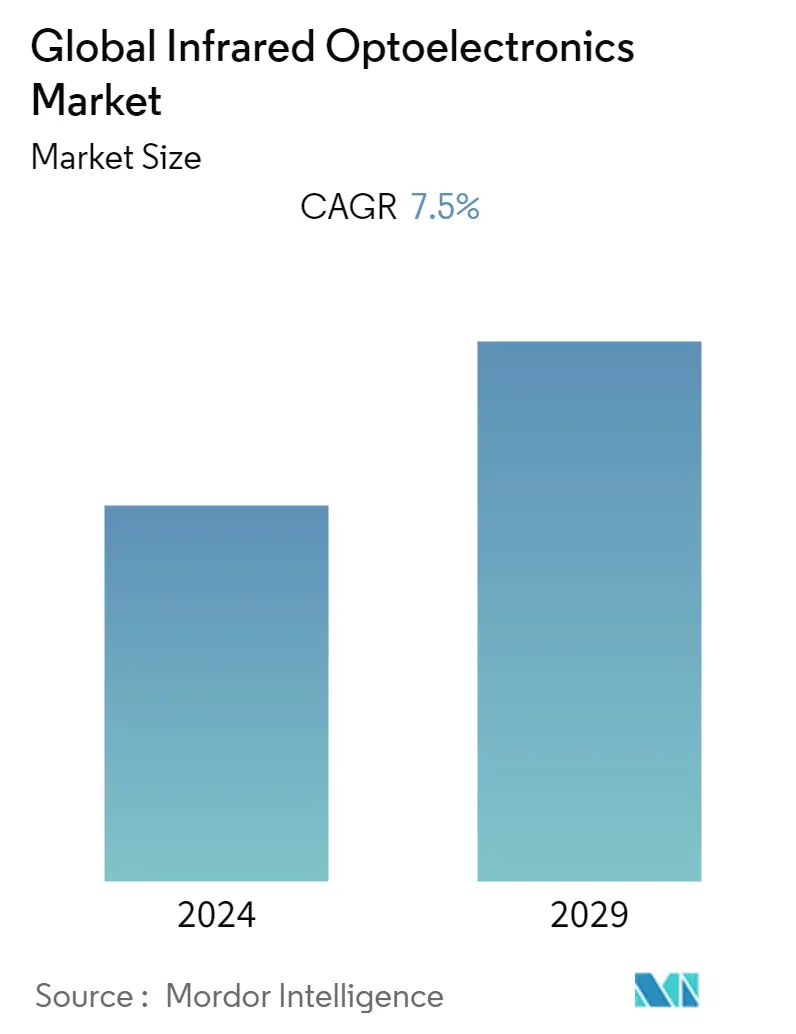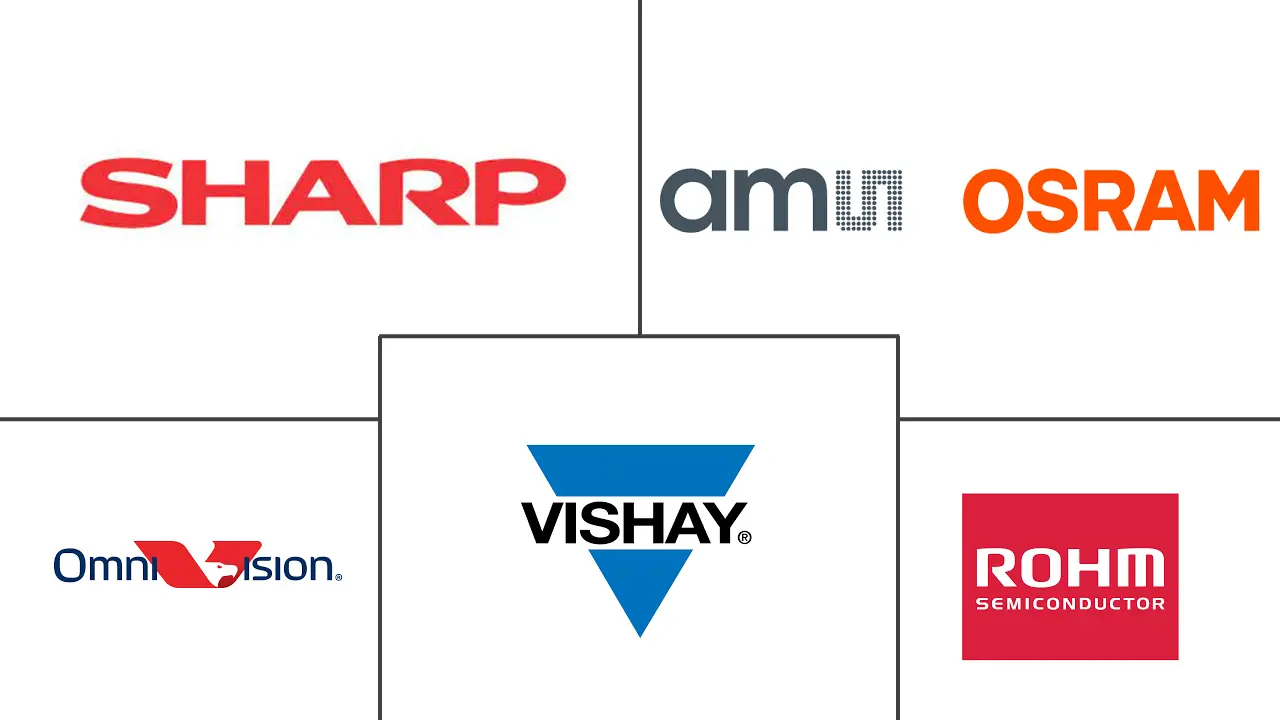Market Size of Global Infrared Optoelectronics Industry

| Study Period | 2019 - 2029 |
| Base Year For Estimation | 2023 |
| CAGR | 7.50 % |
| Fastest Growing Market | Asia-Pacific |
| Largest Market | North America |
| Market Concentration | Medium |
Major Players
*Disclaimer: Major Players sorted in no particular order |
Infrared Optoelectronics Market Analysis
The Global Infrared Optoelectronics Market is expected to register at a CAGR of 7.5 % over the forecast period (2021-2027).With the Outbreak of COVID-19, IRay Technology, a high-tech company specializing in infrared FPA detectors and thermal imaging modules, moved quickly to start producing infrared thermal imagers. As a result, infrared thermal imaging is the optimal and advanced technology, with a wide range of screening, real-time monitoring, and precision of 0.3°C to 0.5°C.
- The National Science Foundation announced to fund a new effort to bring atomic-level precision to the equipment and technologies that underpin much of modern life, which will change industries such as information technology in the coming decades. For instance, in September 2021, The Center for Integration of Modern Optoelectronic Materials on Demand announced a five-year, USD 25 million Science and Technology Center grant sponsored by the University of Washington.
- Growing consumption of advanced manufacturing and fabricating technologies is further driving the consumption of optoelectronic components in the industrial sector, with the use of Infrared (IR) Inspection windows.
- Furthermore, COVID-19 pandemic is espected to impact the given market's growth positively as, Infrared Optoelectronics is an essential component of several modern technologies. In recent years, the healthcare and automotive industries have become important adopters of infrared optoelectronics. The use of infrared optical sensors in biosensing applications in the healthcare business allows for monitoring heart rate and other key organs in the human body.
- Furthermore, the growing need for advanced technologies in the automobile industry is creating a market opportunity for infrared optoelectronics. Most automakers are incorporating infrared components in their vehicles for ambient light detection, estimate, gestured control of the infotainment panel, and night vision. These new application areas help Optoelectronics expand its market share in rising industries.
Infrared Optoelectronics Industry Segmentation
Optoelectronics allows communication between the optics and the electronics that includes designing, studying and manufacturing of a hardware device that converts electrical energy into light energy and light into energy through semiconductors. Near- and mid-infrared optoelectronic devices are utilized in sensing and telecommunication, and are suitable for intra/inter chip optical connections.
The Study covers infrared optoelctronics range that include near-infrared, mid-infrared, long-infrared and tracks the usauge of infrared optoelctronics across major end-users such as automotive, aerospace & defense, consumer rlectronics, information technology, healthcare, residential and commercial, industrial . The study also covers demand across various regions and study considers the impact of COVID-19 on the market.
| By Range | |
| Near-Infrared | |
| Mid-Infrared | |
| Long-Infrared |
| By End User | |
| Aerospace & Defense | |
| Automotive | |
| Information Technology | |
| Consumers electrionics | |
| Healthcare | |
| Residential and Commercial | |
| Industrial | |
| Others |
| Geography | |
| North America | |
| Europe | |
| Asia-pacific | |
| Latin America | |
| Middle East and Africa |
Global Infrared Optoelectronics Market Size Summary
The Global Infrared Optoelectronics Market is poised for significant growth, driven by advancements in technology and increasing applications across various industries. The market is experiencing a surge in demand due to the integration of infrared optoelectronic components in sectors such as healthcare and automotive. In healthcare, these components are utilized for biosensing applications, enabling the monitoring of vital signs with enhanced precision. The automotive industry is also embracing infrared technologies for features like ambient light detection and night vision, which are becoming standard in modern vehicles. The COVID-19 pandemic has further accelerated the adoption of infrared optoelectronics, as these technologies play a crucial role in real-time monitoring and screening processes.
Regionally, Asia-Pacific holds a significant share of the market, supported by substantial investments in smart infrastructure and automation technologies. Countries like Thailand and Japan are leading the charge, with initiatives to boost electric vehicle production and partnerships to enhance market growth. The competitive landscape is characterized by the presence of major players such as Vishay Intertechnology, OSRAM International, and Panasonic Corporation, who are actively engaging in strategic collaborations and technological innovations. These developments are expected to drive the market forward, with ongoing research and projects focusing on expanding the capabilities and applications of infrared optoelectronics in various fields.
Global Infrared Optoelectronics Market Size - Table of Contents
-
1. MARKET INSIGHTS
-
1.1 Market Overview
-
1.2 Porters Five Force Analysis
-
1.2.1 Threat of New Entrants
-
1.2.2 Bargaining Power of Buyers
-
1.2.3 Bargaining Power of Suppliers
-
1.2.4 Threat of Substitute Products
-
1.2.5 Intensity of Competitive Rivalry
-
-
1.3 Assessment of the Impact of COVID -19 on the Market
-
-
2. MARKET SEGMENTATION
-
2.1 By Range
-
2.1.1 Near-Infrared
-
2.1.2 Mid-Infrared
-
2.1.3 Long-Infrared
-
-
2.2 By End User
-
2.2.1 Aerospace & Defense
-
2.2.2 Automotive
-
2.2.3 Information Technology
-
2.2.4 Consumers electrionics
-
2.2.5 Healthcare
-
2.2.6 Residential and Commercial
-
2.2.7 Industrial
-
2.2.8 Others
-
-
2.3 Geography
-
2.3.1 North America
-
2.3.2 Europe
-
2.3.3 Asia-pacific
-
2.3.4 Latin America
-
2.3.5 Middle East and Africa
-
-
Global Infrared Optoelectronics Market Size FAQs
What is the current Global Infrared Optoelectronics Market size?
The Global Infrared Optoelectronics Market is projected to register a CAGR of 7.5% during the forecast period (2024-2029)
Who are the key players in Global Infrared Optoelectronics Market?
Sharp Corporation, Vishay Intertechnology, Inc., ROHM Co., Ltd., OSRAM International GmbH (ams AG) and Omnivision Technologies Inc are the major companies operating in the Global Infrared Optoelectronics Market.

